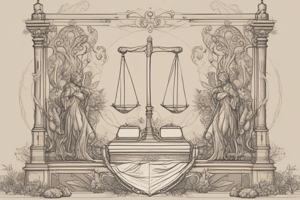Podcast
Questions and Answers
What is the primary function of primary rules according to Hart's theory?
What is the primary function of primary rules according to Hart's theory?
- To classify legal rules into categories
- To resolve disputes arising from the application of rules
- To provide a mechanism for legal change
- To impose obligations on individuals (correct)
Which of the following best describes a secondary rule in Hart's legal theory?
Which of the following best describes a secondary rule in Hart's legal theory?
- Rules that help distinguish unenforced laws
- Rules that address uncertainty in primary rules (correct)
- Rules that impose direct obligations
- Rules that provide procedures for legal change
What is the role of the rule of recognition in Hart's legal system?
What is the role of the rule of recognition in Hart's legal system?
- To abolish outdated laws
- To recognize which rules hold legal status (correct)
- To create new primary rules
- To enforce compliance among citizens
What characteristic might primary rules possess according to Hart's definition?
What characteristic might primary rules possess according to Hart's definition?
Which of the following statements correctly reflects Hart's view on the nature of primary rules?
Which of the following statements correctly reflects Hart's view on the nature of primary rules?
What is a key aspect that differentiates a habit from a legal rule according to the provided content?
What is a key aspect that differentiates a habit from a legal rule according to the provided content?
What constitutes a partial view of the law when considering only primary rules?
What constitutes a partial view of the law when considering only primary rules?
How do primary rules relate to the concept of normative terminology?
How do primary rules relate to the concept of normative terminology?
What does Hart identify as a limitation of Austin's theory of law?
What does Hart identify as a limitation of Austin's theory of law?
What distinction does Hart make regarding the types of laws?
What distinction does Hart make regarding the types of laws?
Which aspect is NOT part of Hart’s argument regarding law as a system of rules?
Which aspect is NOT part of Hart’s argument regarding law as a system of rules?
According to Hart, what characterizes widespread personal habits?
According to Hart, what characterizes widespread personal habits?
What is Austin's view on individualized commands in relation to law?
What is Austin's view on individualized commands in relation to law?
According to Austin's theory, which requirement is essential for something to be considered a sovereign?
According to Austin's theory, which requirement is essential for something to be considered a sovereign?
What is a primary characteristic of social rules according to Hart?
What is a primary characteristic of social rules according to Hart?
How does Hart view the continuity of law's validity?
How does Hart view the continuity of law's validity?
What aspect of Austin's definition of a sovereign has been subject to criticism?
What aspect of Austin's definition of a sovereign has been subject to criticism?
Why is the Offences Against the Person Act 1861 mentioned in the context of sovereignty?
Why is the Offences Against the Person Act 1861 mentioned in the context of sovereignty?
What does the distinction between being obliged and being under an obligation refer to?
What does the distinction between being obliged and being under an obligation refer to?
What is NOT a reason why personal habits differ from social rules in Hart's analysis?
What is NOT a reason why personal habits differ from social rules in Hart's analysis?
What is a potential criticism of Austin's theory regarding compliance with laws?
What is a potential criticism of Austin's theory regarding compliance with laws?
How does Austin characterize a law's command in contrast to a general command requirement?
How does Austin characterize a law's command in contrast to a general command requirement?
What implication does Austin's definition present regarding the existence of laws after the sovereign's death?
What implication does Austin's definition present regarding the existence of laws after the sovereign's death?
What challenge does Austin face regarding his definition of law considering real legal practices?
What challenge does Austin face regarding his definition of law considering real legal practices?
What is the purpose of secondary rules in the context of personal obligations?
What is the purpose of secondary rules in the context of personal obligations?
Which of the following best describes the role of rules of adjudication?
Which of the following best describes the role of rules of adjudication?
How does the rule of recognition relate to the validity of a law?
How does the rule of recognition relate to the validity of a law?
Which statement is true about the relationship between the rule of recognition and existing rules?
Which statement is true about the relationship between the rule of recognition and existing rules?
What happens when mass disobedience occurs regarding a legal rule, such as a speed limit?
What happens when mass disobedience occurs regarding a legal rule, such as a speed limit?
How does Hart illustrate the concept of legal validity?
How does Hart illustrate the concept of legal validity?
What does the rule of recognition establish among legal actors?
What does the rule of recognition establish among legal actors?
Why must a rule exist before the application of the rule of recognition?
Why must a rule exist before the application of the rule of recognition?
What does Hart identify as a characteristic of the rule of recognition in his theory?
What does Hart identify as a characteristic of the rule of recognition in his theory?
According to Hart, what dual perspective can the ultimate rule of recognition be viewed from?
According to Hart, what dual perspective can the ultimate rule of recognition be viewed from?
What does Hart consider to be the 'minimum content' of natural law?
What does Hart consider to be the 'minimum content' of natural law?
What assumptions underlie Hart's notion of the core of good sense in natural law?
What assumptions underlie Hart's notion of the core of good sense in natural law?
How does Hart describe human beings in terms of their social interactions?
How does Hart describe human beings in terms of their social interactions?
What does Hart propose is essential for a viable social organization?
What does Hart propose is essential for a viable social organization?
Which factor does Hart emphasize as necessary for creating a legal and moral obligation?
Which factor does Hart emphasize as necessary for creating a legal and moral obligation?
Which aspect significantly distinguishes soft positivism from hard positivism in Hart's view?
Which aspect significantly distinguishes soft positivism from hard positivism in Hart's view?
Flashcards are hidden until you start studying
Study Notes
Austin's Theory of Law
- Austin's theory of law emphasizes the command of a sovereign as a fundamental element, with sanctions for non-compliance.
- Austin argues that laws are general commands, neglecting the existence of individualized commands like court orders.
- The concept of a sovereign being human excludes divine law from Austin's analysis.
- Criticism of Austin's theory arises from limitations in his definition of a sovereign, particularly the requirement of habitual obedience.
- The existence of laws that predate the sovereign who enacted them challenges Austin's theory.
- Some laws, such as those governing public bodies and private relationships, are not simply commands backed by sanctions.
- Austin's theory fails to address the continuity of law despite the limited lifespan of the sovereign.
Hart's Critique of Austin
- Hart identifies the need for a "fresh start" to understand law, recognizing the shortcomings of Austin's command theory.
- Hart emphasizes the concept of law as a system of rules, recognizing the need to understand individual rules before comprehending their collective effect.
Distinctions in Hart's Theory
- Personal Habits and Social Rules: Convergent behavior, even widespread, does not equate to a rule unless there's critical reflection, conformity, and acknowledgment of norms.
- Obliged vs. Obligated: While "obliged" implies external pressure, "obligated" refers to a sense of duty or obligation arising from internal acceptance of rules.
- Internal and External Aspects of Rules: Rules have internal and external aspects; internal implies an awareness of a standard and a sense of obligation, while external aspects involve the observable behavior conforming to a rule.
Primary and Secondary Rules
- Primary Rules: Primary rules are those that impose obligations, for example, laws requiring payment of taxes or prohibiting murder.
- Secondary Rules: Secondary rules address the limitations of primary rules by providing mechanisms for:
- Rules of Recognition: To identify valid laws and distinguish them from other norms.
- Rules of Change: To allow legal modification and adaptation.
- Rules of Adjudication: To resolve disputes and provide a framework for legal proceedings.
The Rule of Recognition
- The rule of recognition establishes the criteria for legal validity, granting legal status to rules that conform to those criteria.
- It distinguishes legal rules from other norms like social customs.
- The rule of recognition itself is a matter of fact, based on the practices of courts, officials, and individuals in identifying law.
- The rule of recognition can incorporate moral principles or values, reflecting Hart's "soft positivism."
Minimum Content of Natural Law
- Despite his positivist framework, Hart acknowledges "the minimum content of natural law," recognizing certain universally accepted principles essential for the survival and well-being of society.
- These principles are based on generalizations about human vulnerability, limited resources, and the need for cooperation and compromise.
- Examples of these principles include rules restricting violence and promoting mutual forbearance.
Studying That Suits You
Use AI to generate personalized quizzes and flashcards to suit your learning preferences.




